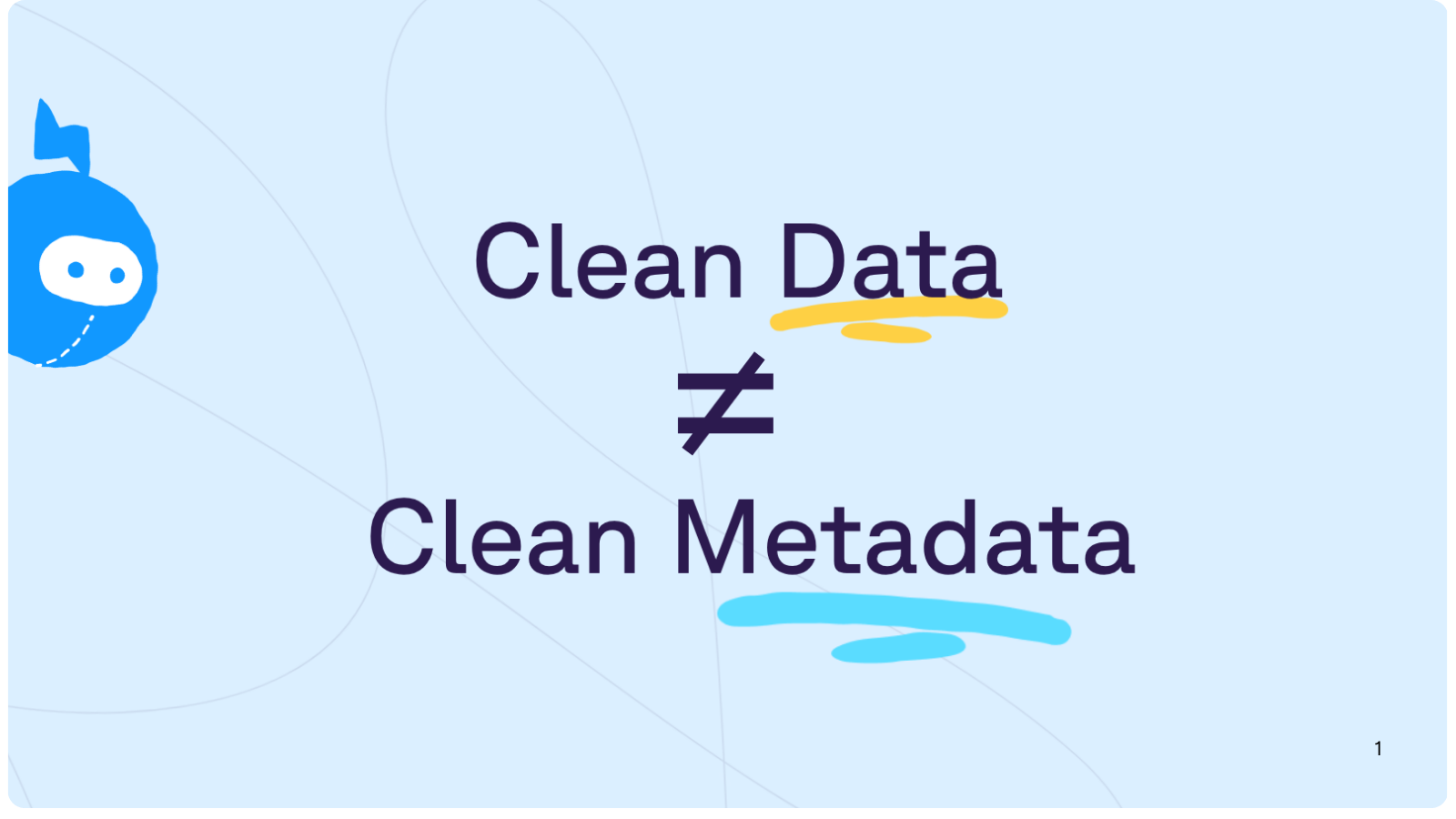No.
And here’s why that confusion keeps biting you on the behind.
There’s a comforting myth in ops: once you’ve deduped the database, normalized addresses, tightened formats, and scrubbed obvious junk, you’re “clean.”
But data is only half the room.
Metadata — the definitions, the picklists, the API names, the permissions, the automations, and the lineage that give data its meaning and motion —can be spotless or chaotic regardless of how neat the rows look.
Think of data as water and metadata as the pipes, valves, labels, and even yes the building code. You can filter the water perfectly and still flood the building if the valves are mislabeled or the diagrams don’t match your reality.
This is why “clean” data still misroutes, mislabels, and misleads.
When the semantics drift or the machinery is ungoverned, outcomes go sideways quietly. Reports don’t throw errors; campaigns don’t scream; AI doesn’t blush as though they're embarrassed. Oh heavens no. It just gives you confident nonsense and moves on.
Five scenes from the ops multiverse
1) The Picklist Forklift
Sales wants a simple world: Open to Working to Qualified. Marketing marches to a different drum: New to MQL to SAL. An integration partner brings its own canon: Prospect to Engaged.
None of these are “wrong,” per se, and each team keeps its data tidy. Then routing breaks. A lead enters a flow that expects Working but arrives labeled SAL, and the record slips into a gray branch that wasn’t designed for it. In dashboards, nothing looks broken; in the trenches, reps ask, “Where did that hot lead go?” It didn’t disappear — it took the only path your metadata allowed.
2) The Premium Dashboard Mirage
A BI chart glows with a 14% “wins due to partner.” Cue many high-fives and budget plans. But three months earlier, someone repurposed Partner_Source__c from “sourced by partner” to “influenced by partner.” The data didn’t lie; the field’s meaning changed. The graph remained beautiful, and the decisions it inspired veered off reality. This is metadata drift in its purest form: silent, plausible, and expensive.
3) The API Name Booby Trap
An admin tidies a label, for instance “Industry (New)” becomes “Industry”—and leaves the API as Industry_New__c. Feels harmless.
Somewhere else, prompts, SQL, and ETL jobs still point at Industry__c. Half your downstream logic reads from an empty room; the other half reads from the real one. Everything runs. Nothing agrees. Days later, a week slips away to track down why “Industry” seems to flicker between two truths.
4) The Validation Rule That Ate Q3
To block junk opportunities, ops adds a validation rule that requires a handful of fields at creation. Reasonable. Accidentally, the rule also thwarts a downstream system from setting Close Date on renewals. The result is a queue of perfectly clean, perfectly stuck deals. No alarms blare. Renewals slip, leaders grumble about “sales discipline,” and Q3 ends with a shrug. Only after a postmortem does the team realize the culprit was a tidy little rule with fuzzy metadata around who was allowed to set what, and when.
5) The Permission Swiss Cheese
In the name of clarity, RevOps hides a few fields from SDRs to reduce page clutter. CSMs do their own spring cleaning. Now the same story gets logged in two different custom fields, each invisible to the other team. Both fields are “clean.” Neither is shared. The so-called “single source of truth” becomes a choose-your-own-adventure. When leadership asks for a simple roll-up, you discover that cleanliness without coherence is just well-organized isolation.
Why clean data still goes haywire
Metadata governs five things: what a field means (semantics), how it’s shaped (structure), who can touch it (control), what moves it (behavior), and what depends on it (lineage).
A wobble in any layer can make perfectly valid data behave in surprising ways. Rename a label and the report still runs, but it now filters on yesterday’s idea.
Add a picklist value in one object but not its twin, and routing becomes probabilistic.
Expand field visibility for speed, or restrict it for focus, and you’ve split the truth across teams.
None of this makes the data “dirty.” It just makes outcomes untrustworthy.
This is why AI, in particular, is especially fragile. Models rely on metadata to infer vital meaning, join tables, and contextualize fields. When semantics go adrift, AI produces fluent answers about the wrong thing. It’s not malicious, in fact it’s actually the exact opposite: overly obedient.
A two-week reset that actually sticks
You don’t need a months-long program to stop the bleeding. Start with intent, then harmonize from there, friend!
In week one, inventory your world and name things on purpose. Export the schema for your core objects.
Collapse synonyms so Status, Stage, and State stop pretending to be different ideas. Write a one-page “concept canon” for the handful of fields that drive revenue: MQL, SAL, Status, Region, Industry, Source... what each means, when it changes, and who owns it.
Put real owners on fields (by role, not person) and make ownership visible. That decision alone shrinks the number of “temporary” fields destined to become permanent orphans.
In week two, make the system deterministic. Harmonize the most critical picklists across objects so the same concept carries the same set of values everywhere it appears. Add short, useful descriptions where it matters: why the field exists, who can change it, what values are allowed, what will break if it changes.
Consolidate flows so each object has clear entry points instead of a spaghetti bowl of overlapping automations. Add a lightweight change gate: no schema PR without the owner’s nod and a quick note on lineage—“changing X impacts Y reports, Z prompts, and these ETL jobs.” Finally, institute a 20-minute weekly metadata review. Not a ceremony, not a stand-up—just a tiny, relentless habit that prevents the quiet rot.
What this opens up (beyond “it feels cleaner”)
When metadata is coherent, routing stops feeling like whack-a-mole. Joins across CRM, MAP, CS, billing become trustworthy. Dashboards survive label changes. Prompts don’t decay when a field flips shape. And changes become reversible because the blast radius is visible before you push them. “Clean” data finally flows through a sane, predictable maze. And the maze, not the mop, is what makes revenue reliable.
Where Sweep fits in
Sweep treats metadata as the first-class surface it deserves to be.
It auto-discovers fields, flows, and dependencies, and shows usage heatmaps next to “what breaks if…” previews so you don’t have to guess. It proposes harmonized picklists across objects (and gives you safe rollbacks when humans do human things). It tracks lineage from field to report to prompt/ETL so AI and BI don’t quietly drift apart.
It nudges you to add owners, descriptions, and change gates where you already work. And it surfaces dead fields and shadow schemas before they harden into costly habits. The overall effect is boring in the best way ( 🤌): fewer mysteries, fewer rollbacks, and a team that trusts the system again.
One-screen checklist to end this thing on
- Canonical definitions for Status, Source, Region, Industry, Lifecycle
- Identical picklists for shared concepts across objects
- Clear owner + purpose + allowed values on every field that matters
- Flow consolidation with documented entry points
- Lineage map for the top 25 reports and top 10 prompts
- Weekly 20-minute metadata review across RevOps, Sales, CS, and Marketing
- A small dashboard for metadata health (description coverage, picklist harmony, dead fields, change failure rate, “time to answer what breaks if we change X”)
Clean data without clean metadata is a well-mopped hallway leading into a maze.
Stop the mopping. Fix the maze. Find the cheddar. 🧀🐁

